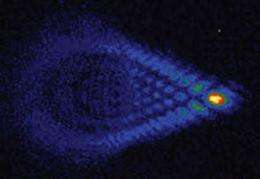Extreme imaging wins science praise

A Griffith University PhD candidate has been highly awarded for his innovative image of the shadow of a single atom.
Ben Norton, from the Kielpinski group in the Centre for Quantum Dynamics, was runner up in the CiSRA Extreme Imaging Competition following extensive work on high resolution imaging.
Run by Canon Australia and CiSRA, Canon Inc.'s Australian research centre, the Extreme Imaging competition aims to promote and celebrate local research at the intersection of imaging and technology.
"Atoms are the building blocks of matter. A human hair is a billion atoms wide," said Professor David Kielpinski, from Griffith's Centre for Quantum Dynamics. "So just manipulating and isolating a single atom is extremely difficult, let alone imaging it.
"Ben has had to use some very special tricks to do both.
"First of all he cools them down, to within a degree of 'absolute zero', the coldest temperature possible (about−273.15 °C), to keep them still. Then he traps them inside an ultra-high vacuum, holding them steady using electric fields. These techniques are very hard, but they have been done before. What is new is how Ben images them.
"To do this he uses a special flat lens made using concentric rings, which was originally developed for lighthouses. These lenses can be made so small and light that they can be put inside the vacuum chamber with the atoms, allowing Ben to collect as much light as possible. This last trick has allowed Ben to take some of the highest resolution images of atoms ever made, including the first ever image of the shadow of a single atom, by measuring how much light is absorbed when the atom is there."
Professor Kielpinski said imaging single atoms is important for understanding not just physics, but also in the new field of quantum computing. "The techniques developed in this project may have other applications too, such as ultra-high resolution imaging of biological cells.
"I really appreciate that this work has been considered worthy of the Canon prize – it's been an amazing opportunity. I am also very grateful for the strong support I have received from my supervisors at Griffith throughout my research there."
Provided by Griffith University



















